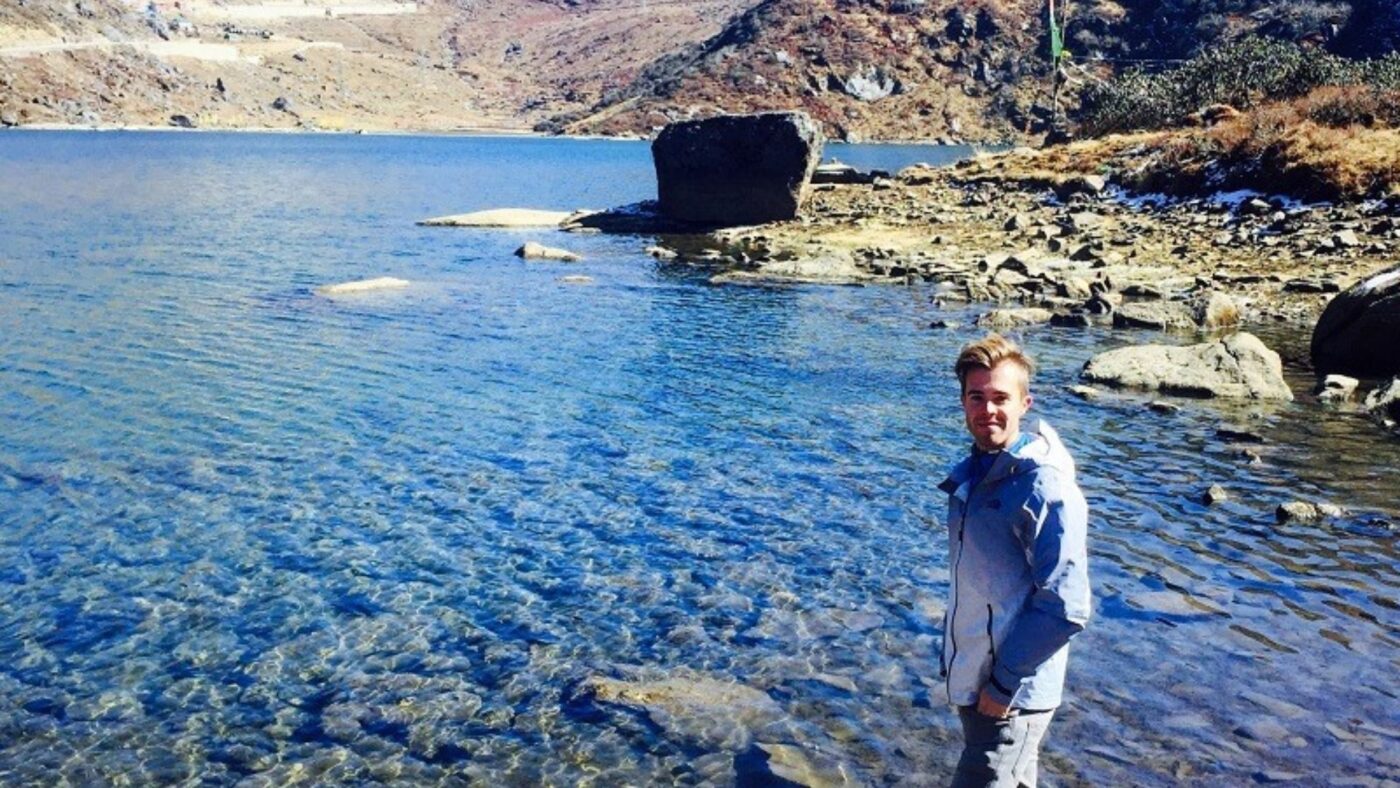Fulbright-Nehru research scholar Alexander O’Neill has worked to support environmental conservation efforts in India.
May 2019

Fulbright-Nehru research scholar Alexander O’Neill at Tsomgo Lake in Sikkim. Photograph courtesy Alexander O’Neill
The Fulbright Program of the U.S. State Department prepares participants to address challenges related to various global issues of our time, from economic development to environmental sustainability. One such participant is Alexander O’Neill, a 2015 U.S. Fulbright-Nehru student researcher. He is currently a graduate candidate in environmental management and forestry science at Duke University, North Carolina. As a Fulbright-Nehru research scholar, he supported India’s ongoing efforts to document the biocultural diversity of the Sikkim Eastern Himalayas. He has also received University of Maryland’s College Park Scholars Co-curricular Scholarship to support Jagran Jan Vikas Samiti in its efforts to conserve medicinal plants and restore Rajasthan’s landscape.
Excerpts from an interview.
Please tell us a bit about yourself and your educational background.
I am a Duke Master of Environmental Management and Master of Forestry interested in science diplomacy. Growing up in Washington, D.C., I spent many days roaming in Rock Creek Park, catching crawfish, constructing forts and collecting botanical oddities. Washington, D.C., is an incredibly diverse place. By simply living there, I was introduced to unique perspectives on environmental relationships—how people see themselves in relation to the planet. As an undergraduate at Georgetown University, I was fortunate to study these relationships at a more granular level. Through conservation genetics, I learned how the environment shapes genes and, more so, determines how and when genes are expressed. Around this time, I was also introduced to environmental humanities. This was a marked pivot in my academic career. I began to see how the conservation endeavor was not something outside of humans; that is, “natural” systems were not always better without humans involved. At Duke University, I have operationalized my understanding of environmental management through my dual masters. My hope is to one day translate science into policy with the U.S. Department of State.
What, according to you, are some of the biggest environmental threats in today’s world? What do you deem as effective strategies to combat these threats?
Deforestation, overpopulation, climate change, biodiversity loss and pollution frame the vast majority of environmental news headlines. They are interconnected, and there is no silver bullet.
What I see as a significant challenge for a sustainable future, however, is maintaining relationships with the environment. Our planet is sub-urbanizing. People are moving to cities, and we are absorbed by technology. These developments disconnect us from nature. Without a deep connection to natural systems, how can our leaders effectively communicate environmental policy?
For addressing this, I find particular value in conserving and managing forestland. Forests are the primary store of biological diversity. However, in our changing climate, they will also be essential for sequestering carbon, maintaining water stores, and replenishing renewable resources.
Please tell us about your work as a Graduate Student Intern at the U.S. State Department.
What a fantastic opportunity! In Summer 2018, I received a graduate fellowship from the Edna Bailey Sussman Foundation to work with the U.S. State Department’s Bureau of Oceans and International Environmental and Scientific Affairs. With the Office of Environmental Quality and Transboundary Issues, I coordinated the U.S. interagency assessment of the United Nations Environment Program (UNEP) Global Environmental Outlook 6 (GEO-6). This report is an independent review of the state of the environment and policy response to address global change. I also helped review Global Environment Facility proposals, focusing on programs affiliated with South and Central Asian nations.
You were a Fulbright-Nehru Research Scholar in 2015-16. What project did you undertake as part of the fellowship?
As a Fulbright Scholar, I explored biological and cultural diversity in Sikkim. Focusing on sacred wetlands, I was interested in ways that people envision and respond to environmental change. This program also involved researching how the people of Sikkim utilize non-timber forest products for food and medicine. Our team found that over 1,100 species have reported uses in the state, and that the vast majority of these species are not found within its protected areas.
In what ways can biocultural literature help inform the strategies for sustainable development and ecological protection?
Scientists must work within cultural systems when conserving environmental resources, particularly in biologically and culturally diverse places like South and Central Asia. Biocultural literature provide a baseline to understand how people see themselves in relation to the environment. They capture traditional ways of knowing that are essential for sustainable outcomes.
Please tell us about your work to support the Botanical Survey of India’s efforts to assess the conservation status of orchids in the eastern Himalaya.
At the International Union for Conservation of Nature (IUCN), I communicated with both community leaders and geneticists in order to assess the conservation status of ethnobotanical plants. I learned that community knowledge and science can complement one another and expand our conservation policies with regard to the Red List of Threatened Species. The Botanical Survey of India, particularly Dr. D.K. Agrawala in the Sikkim unit, leads these initiatives as they relate to orchids.
You also received a College Park Scholars Co-curricular Scholarship to support Jagran Jan Vikas Samiti in Rajasthan. Could you please tell us more about your work with the organization?
I was first exposed to traditional knowledge in conservation while volunteering with Jagran Jan Vikas Samiti in Rajasthan. Through the Guniyon Ka Khazana Initiative, I helped traditional doctors establish seed banks and restore local habitat using medicinal plants. Our strategy integrated community knowledge into landscape restoration, promoting biological and cultural conservation in the Thar Desert.
COMMENTS